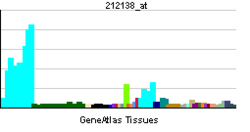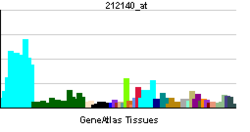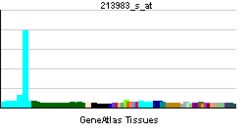- PDS5A
-
PDS5, regulator of cohesion maintenance, homolog A (S. cerevisiae) Identifiers Symbols PDS5A; DKFZp686B19246; FLJ41012; KIAA0648; MGC131948; MGC161503; SCC-112 External IDs OMIM: 613200 MGI: 1918771 HomoloGene: 22877 GeneCards: PDS5A Gene Gene Ontology Molecular function • protein binding
• identical protein bindingCellular component • chromatin
• nucleusBiological process • cell cycle
• mitosis
• negative regulation of DNA replication
• cell divisionSources: Amigo / QuickGO RNA expression pattern 


More reference expression data Orthologs Species Human Mouse Entrez 23244 71521 Ensembl ENSG00000121892 ENSMUSG00000029202 UniProt Q29RF7 n/a RefSeq (mRNA) NM_001100399.1 NM_001081321.1 RefSeq (protein) NP_001093869.1 NP_001074790.1 Location (UCSC) Chr 4:
39.82 – 39.98 MbChr 5:
66.01 – 66.09 MbPubMed search [1] [2] Sister chromatid cohesion protein PDS5 homolog A is a protein that in humans is encoded by the PDS5A gene.[1][2][3]
References
- ^ Sumara I, Vorlaufer E, Gieffers C, Peters BH, Peters JM (Dec 2000). "Characterization of Vertebrate Cohesin Complexes and Their Regulation in Prophase". J Cell Biol 151 (4): 749–62. doi:10.1083/jcb.151.4.749. PMC 2169443. PMID 11076961. http://www.pubmedcentral.nih.gov/articlerender.fcgi?tool=pmcentrez&artid=2169443.
- ^ Losada A, Yokochi T, Hirano T (May 2005). "Functional contribution of Pds5 to cohesin-mediated cohesion in human cells and Xenopus egg extracts". J Cell Sci 118 (Pt 10): 2133–41. doi:10.1242/jcs.02355. PMID 15855230.
- ^ "Entrez Gene: SCC-112 SCC-112 protein". http://www.ncbi.nlm.nih.gov/sites/entrez?Db=gene&Cmd=ShowDetailView&TermToSearch=23244.
Further reading
- Ishikawa K, Nagase T, Suyama M et al. (1998). "Prediction of the coding sequences of unidentified human genes. X. The complete sequences of 100 new cDNA clones from brain which can code for large proteins in vitro". DNA Res. 5 (3): 169–76. doi:10.1093/dnares/5.3.169. PMID 9734811.
- Gregson HC, Schmiesing JA, Kim JS et al. (2002). "A potential role for human cohesin in mitotic spindle aster assembly". J. Biol. Chem. 276 (50): 47575–82. doi:10.1074/jbc.M103364200. PMID 11590136.
- Strausberg RL, Feingold EA, Grouse LH et al. (2003). "Generation and initial analysis of more than 15,000 full-length human and mouse cDNA sequences". Proc. Natl. Acad. Sci. U.S.A. 99 (26): 16899–903. doi:10.1073/pnas.242603899. PMC 139241. PMID 12477932. http://www.pubmedcentral.nih.gov/articlerender.fcgi?tool=pmcentrez&artid=139241.
- Ota T, Suzuki Y, Nishikawa T et al. (2004). "Complete sequencing and characterization of 21,243 full-length human cDNAs". Nat. Genet. 36 (1): 40–5. doi:10.1038/ng1285. PMID 14702039.
- Kumar D, Sakabe I, Patel S et al. (2004). "SCC-112, a novel cell cycle-regulated molecule, exhibits reduced expression in human renal carcinomas". Gene 328: 187–96. doi:10.1016/j.gene.2003.12.013. PMID 15019998.
- Rankin S, Ayad NG, Kirschner MW (2005). "Sororin, a substrate of the anaphase-promoting complex, is required for sister chromatid cohesion in vertebrates". Mol. Cell 18 (2): 185–200. doi:10.1016/j.molcel.2005.03.017. PMID 15837422.
- Ewing RM, Chu P, Elisma F et al. (2007). "Large-scale mapping of human protein–protein interactions by mass spectrometry". Mol. Syst. Biol. 3 (1): 89. doi:10.1038/msb4100134. PMC 1847948. PMID 17353931. http://www.pubmedcentral.nih.gov/articlerender.fcgi?tool=pmcentrez&artid=1847948.
Categories:- Human proteins
- Chromosome 4 gene stubs
Wikimedia Foundation. 2010.
